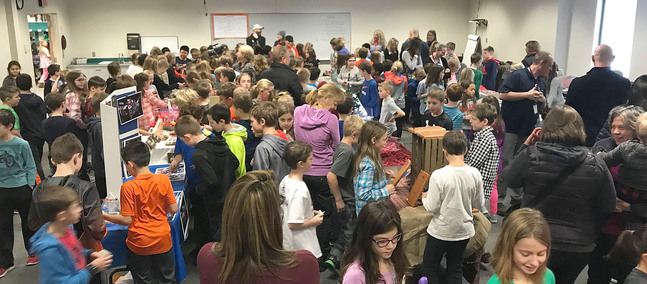Mall Madness teaches business skills
Posted on: Jan 11, 2018

The business world can be an exciting but unforgiving place, and fourth-graders in the talent development program at Delano Elementary recently experienced a taste of it through their Mall Madness unit.
About 25 students in the math-focused section developed the idea for a business, then applied for an artificial small business loan and state business license, as well as space to rent in a “mall” set up in the elementary school’s large multi-purpose room.
They also made decisions on how much and what kind of advertising to purchase before creating or acquiring their products, naming them and ultimately selling them at the annual Mall Madness day (see video here). Through it all the students kept their own checkbooks and monitored their account balances.
On Mall Madness day all the fourth-graders in the school, plus some parents and staff, passed through the room where the products were displayed for sale vendor-style. Each vendor was required to have at least 15 of their products, which ranged from cribbage boards to decorated rocks, but they were also allowed to have more if they thought the market would support it. One vendor sold out of her stress balls in five minutes flat. The student with the most items, 48, sold all but six.
Afterward, the entrepreneurs evaluated their decisions on advertising, inventory and more.
“It’s about the decision-making process, what really goes into a business,” said Gwen Briesemeister, the gifted/talented coordinator for Delano Public Schools. “It helps them understand that it’s not all luck. There is thought that goes into it. And afterward they evaluate their choices and why someone else might have been more successful than they were. They look at the money they brought in, the pricing of their products -- all those things are everyday essential skills that students in business need to have.”
Some students made their own products, like hair bows or Tiger signs. Others collected and sold items made by family members or pedaled products that were acquired in some other manner.
“They have different tools at home and there are skills where maybe certain people can help,” said Briesemeister. “Grandmas might do some crocheting, or parents or older siblings can help. They’re allowed to pull any resources they have.”
After the sales were completed, students learned how businesses in town show appreciation for their customers through donations or giveaways, then donated about 10 percent of their earnings back to the fourth-grade class for a party, games or some other use to be determined by the teachers.
In all, the unit ran from September to December, with some extra business-related items worked in.
“It has been a really fun project for the kids to do,” said Briesemeiester. “They are always really excited about it, especially when they can take home their $14 or whatever they made at the end. They just love that. Most of the kids are very successful and they learn a lot.”
Student experience
The opportunity to make business decisions and sell their products to real customers made the learning come alive for students.
“It was cool that we had a real business and made real money. It wasn’t all just pretend,” said Luke Gilliland, who made about 40 sports posters and sold all but three.
One pretend duty involved managing a checkbook, but Eddie Binsfeld, who made his own cribbage boards, said that was his favorite part of the unit because it made the activity seem real.
During the course of Mall Madness day students learned the importance of a good display, and Binsfeld said the taller displays seemed to attract the most attention. Sydney Pink produced and sold 20 bookmarks, and said setting up was time-consuming but worthwhile.
“It was a fun experience, but there was quite a lot of work to prepare for it,” she said.
Binsfeld agreed.
“It was actually kind of stressful because there was real money at stake,” he said.
Successful or not, Christmas ornament merchant Hayden Rue said the activity was still exciting for all involved.
“Even the people that didn’t sell a lot still had fun,” he said.
The students agreed that they now look at stores a bit differently when they visit, knowing some of the considerations that go on behind the scenes to make a profit. Taking into account the utility of the products and how much store owners spent to acquire them, for example, is a new line of thought.
“Most people didn’t make much money (on Mall Madness day) because they had put a lot into it beforehand,” said Binsfeld.
Gilliland was left with a lingering appreciation for the time business people take to pursue success.
“What we went through, it was kind of like what business people really deal with,” he said. “We only had one product, but they have tons of products to think about.”
Mall Madness day was hectic and crowded, but Gilliland said that was all part of the experience.
“Now I know what salespeople feel like on Black Friday,” he said.